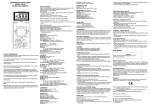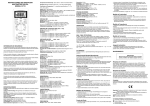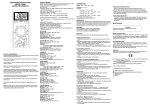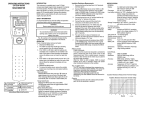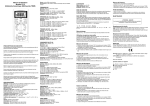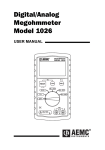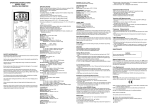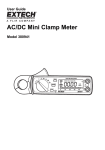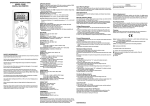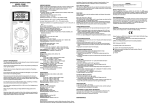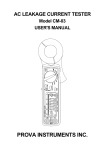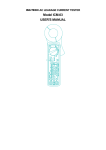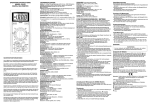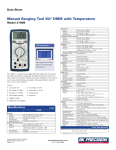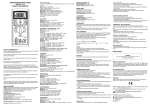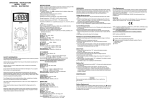Transcript
OPERATING INSTRUCTIONS MODEL 2704C DIGITAL MULTIMETER Accuracy: ±(4% rdg + 10 dgts) Discharge capacitor before connecting SPECIFICATIONS Display: 3½ digit liquid crystal display (LCD) with a maximum reading of 1999. Polarity: Automatic, positive implied, negative polarity indication. Overrange: (OL) or (-OL) is displayed. Zero: Automatic. Low battery indication: The " " is displayed when the battery voltage drops below the operating level. Measurement rate: 2.5 times per second, nominal. Operating environment: 0℃ to 50℃ at < 70% relative humidity. Storage temperature: -20℃ to 60℃, 0 to 80% relative humidity. Temperature Coefficient: 0.1 x (specified accuracy) per ℃. (℃ to 18℃, 28℃ to V A A 50℃). Altitude: 6562 feet (2000m). Power: Single stand ard 9-volt battery, NEDA 1604, JIS 006P, IEC 6F22. Battery life: 150 hours typical with carbon-zinc. Dimensions: 165mm (H) x78mm (W) x42.5mm (D). Weight: Approx. 10.0 oz.(285g) including holster. Accessories: One set test leads, one spare fuse, 9V battery (installed), and Operating Instructions. DC VOLTS Ranges: 200mV, 2V, 20V, 200V, 1000V Resolution: 0.1mV Accuracy: ± ( 0.8% rdg + 1 dgt) Input impedance: 10MΩ Overload protection: 1000VDC or 750VAC rms 600VDC/AC rms 15 seconds on 200mV range F mA COM Range: 0 ~ 1000 Base current: 10uAdc approx. (VCE = 3.0Vdc) FREQUENCY (Autoranging) Ranges: 2kHz, 20kHz, 200kHz, 2MHz,20MHz Resolution: 1Hz Accuracy: ±(0.1% rdg + 3 dgts) Sensitivity: 2.0V RMS min Minimum pulse width: 25ns Duty cycle limits: >30% and <70% Overload protection: 500VDC or AC rms Accuracy: Stated accuracy at 23 ℃ ±5℃, < 75% relative humidity. 2704C V TRANSISTOR hFE Hz V 10A SAFETY INFORMATION The following safety information must be observed to ensure maximum personal safety during the operation at this meter: Use the meter only as specified in this manual or the protection provided by the meter might be impaired. Test the meter on a known voltage before using it to determine if hazardous voltage is present. Do not use the meter if the meter or test leads look damaged, or if you suspect that the meter is not operating properly. Never ground yourself when taking electrical measurements. Do not touch exposed metal pipes, outlets, fixtures, etc., which might be at ground potential. Keep your body isolated from ground by using dry clothing, rubber shoes, rubber mats, or any approved insulating material. Turn off power to the circuit under test before cutting, unsoldering, or breaking the circuit. Small amounts of current can be dangerous. Use caution when working above 60V dc or 30V ac rms. Such voltages pose a shock hazard. When using the probes, keep your fingers behind the finger guards on the probes. Measuring voltage which exceeds the limits of the multimeter may damage the meter and expose the operator to a shock hazard. Always recognize the meter voltage limits as stated on the front of the meter. 99 Washington Street Melrose, MA 02176 Phone 781-665-1400 Toll Free 1-800-517-8431 Visit us at www.TestEquipmentDepot.com AC VOLTS (50Hz - 500Hz) Ranges: 200mV, 2V, 20V, 200V, 750V Resolution: 0.1mV Accuracy: ± ( 1.5% rdg + 5 dgts) on 200mV to 20V ranges ± ( 2.0% rdg + 5 dgts) on 200V,750V ranges Input impedance: 10MΩ Overload protection: 1000VDC or 750VAC rms 600VDC/AC rms 15 seconds on 200mV range CURRENT DC Ranges: 20mA, 200mA, 10A DC Resolution: 10uA DC Accuracy: ± ( 1.0% rdg + 1 dgts) on 20mA to 200mA ranges ± ( 3.0% rdg + 3 dgts) on 10A range DC Input protection: 0.5A/500V fast blow ceramic fuse 10A/600V fast blow ceramic fuse AC Ranges: 20mA, 200mA, 10A (50Hz ~ 500Hz) AC Resolution: 10uA AC Accuracy: ± ( 2.0% rdg + 5dgts) on 20mA to 200mA ranges ± ( 3.5% rdg + 5 dgts) on 10A range AC Input protection: 0.5A/500V fast blow ceramic fuse 10A/600V fast blow ceramic fuse 10A AC & DC Input : 10A for 60 seconds maximum followed by a 10 minute cooling period RESISTANCE Ranges: 200Ω, 2kΩ200kΩ, 20MΩ, 2000MΩ Resolution: 0.1Ω Accuracy: ± ( 1.0% rdg + 4 dgts) on 200Ωto 200kΩranges ± ( 2.0% rdg + 4 dgts) on 20MΩrange ± [ (5.0% rdg - 10 dgts) +10dgts] on 2000MΩrange Open circuit volts typical: 0.3Vdc (3.0Vdc on 200Ω, 2000MΩranges) Overload protection: 500VDC or AC rms CONTINUITY Audible indication: Less than 100Ω Response time: 100ms Overload protection: 500VDC or AC rms DIODE TEST Test current: Approx. 1.0mA Accuracy: ±(1.5% rdg + 3dgts) Open circuit volts: 3.0Vdc typical Overload protection: 500VDC or AC rms CAPACITANCE Ranges: 2nF, 20nF, 200nF, 2uF, 20uF Resolution: 1PF LOGIC TEST Threshold: Logic Hi (2.8 ±0.8V) Logic Lo (0.8 ±0.5V) Indication: 40 msec beep at logic low Overload protection: 500VDC or AC rms OPERATION Before taking any measurements, read the Safety Information Section. Always examine the instrument for damage, contamination (excessive dirt, grease, etc.) and defects. Examine the test leads for cracked or frayed insulation. If any abnormal conditions exist do not attempt to make any measurements. Input Warning Beeper The meter has a beeper that warns the user when the test lead is in the current jack while the meter is switched to make a voltage measurement. Another safety feature to protect the meter and you. Data Hold Press [HOLD] button to lock the reading on display, and release it by pressing the button again . MAX/MIN Press MAX/MIN once begins recording MIN and MAX. Press MAX/MIN to select current reading MIN or MAX. Hold down for 2 seconds to exit MAX/MIN function. Voltage Measurements 1.Connect the red test lead to ”VΩ” jack and the black test lead to the ”COM” jack. 2.Set the Function/Range switch to the desired voltage type (AC or DC) and range. If magnitude of voltage is not known, set switch to the highest range and reduce until a satisfactory reading is obtained. 3.Connect the test leads to the device or circuit being measured. 4. For dc, a (-) sign is displayed for negative polarity; positive polarity is implied. Current Measurements 1.Connect the red test lead to the ( mA or 10A) jack and the black test lead to the “COM” jack. 2.Set the Function/Range switch to the DC or AC ranges. 3.Remove power from the circuit under test and open the normal circuit path where the measurement is to be taken. Connect the meter in series with the circuit. 4.Apply power and read the value from the display. Resistance and Continuity Measurements 1.Set the Function/Range switch to the desired resistance range or continuity position. 2.Remove power from the equipment under test. 3.Connect the red test lead to the “ VΩ” jack and the black test lead to the ”C O M ” jack. 4.Touch the probes to the test points. In ohms, the value indicated in the display is the measured value of resistance. In continuity test, the beeper sounds continuously, if the resistance is less than 100Ω. Note when using 2000MΩ Range The 2000MΩrange has a fixed 10-count offset in the reading. When the test leads are shorted together in this range, the meter will display 010. This residual reading must be subtracted from the reading. For example, when measuring 1100MΩon the 2000MΩrange, the display will read 1100, from which the 10 residual is subtracted to obtain the actual resistance of 1100MΩ. Diode Tests 1.Connect the red test lead to the “ VΩ” jack and the black test lead to the ”C O M ” jack. 2.Set the Function/Range switch to the “ “ position. 3.Turn off power to the circuit under test. 4.Touch probes to the diode. A forward-voltage drop is about 0.6V (typical for a silicon diode). 5.Reverse probes. If the diode is good, “OL” is displayed. If the diode is shorted, “000” or another number is displayed. 6. If the diode is open, “OL” is displayed in both directions. Capacitance Measurements 1.Set the Function/Range switch to the desired F (capacitance) range. 2.Never apply an external voltage to the Cx sockets. Damage to the meter rnay result. 3.Insert the capacitor directly into the Cx sockets. 4.Read the capacitance directly from the display. Transistor hFE Measurements 1.Set the Function/Range switch to the desired hFE range (PNP or NPN type transistor). 2.Never apply an external voltage to the hFE sockets. Damage to the meter may result. 3.Plug the transistor directly into the hFE sockets. The sockets are labeled E, B, and C for emitter, base, and collector. 4.Read the transistor hFE directly from the display. Frequency Measurements 1.Set the Function/Range switch to the ”Hz” position. 2.Connect the red test lead to the “VΩ” jack and the black test lead to the ”COM” jack. 3.Connect the test leads to the point of measurement and read the frequency from the display. Logic Measurements 1.Set the Function/Range switch to the “LOGIC” position. 2.Connect the red test lead to “V Ω” jack and the black test lead to the ”C O M ” jack. 3.Connect the red test lead to the test point and the black lead to the common buss of the logic circuit. 4. A “▲”on the display indicates TTL logic high and a “ ▼”indicates a TTL logic low. Both indicators are on when the point of measurement is toggling high and low. MAINTENANCE WARNING Remove test leads before changing battery or fuse or performing any servicing. Battery Replacement Power is supplied by a 9 volt battery. (NEDA 1604, IEC 6F22). The " " appears on the LCD display when replacement is needed. To replace the battery, remove the three screws from the back of the meter and lift off the front case. Remove the battery from case bottom. Fuse Replacement If no current measurements are possible. Check for a blown overload protection fuse. For access to fuses, remove the three screws from the back of the meter and lift off the front case. Replace F1 only with the original type 0.5A/500V, fast acting ceramic fuse, 6.35x32mm . Replace F2 only with the original type 10A/600V, fast acting ceramic fuse, 6.35x25.4mm . Cleaning Wipe the case with a damp cloth and mild detergent. Do not use abrasives or solvents. Dirt or moisture in the terminals can affect readings. Safety: Conforms to IEC61010-1 (EN61010-1), CATII 1000V, CATIII 600V, Class II, Pollution degree 2 Indoor use. CATII: Is for measurements performed on circuits directly connected to the low-voltage installation. CAT III: Is for measurements performed in the building installation. EMC: Conforms to EN61326. The symbols used on this instrument are: Caution, refer to accompanying documents Equipment protected throughout by Double insulation (Class II) Alternating current Direct current Ground
